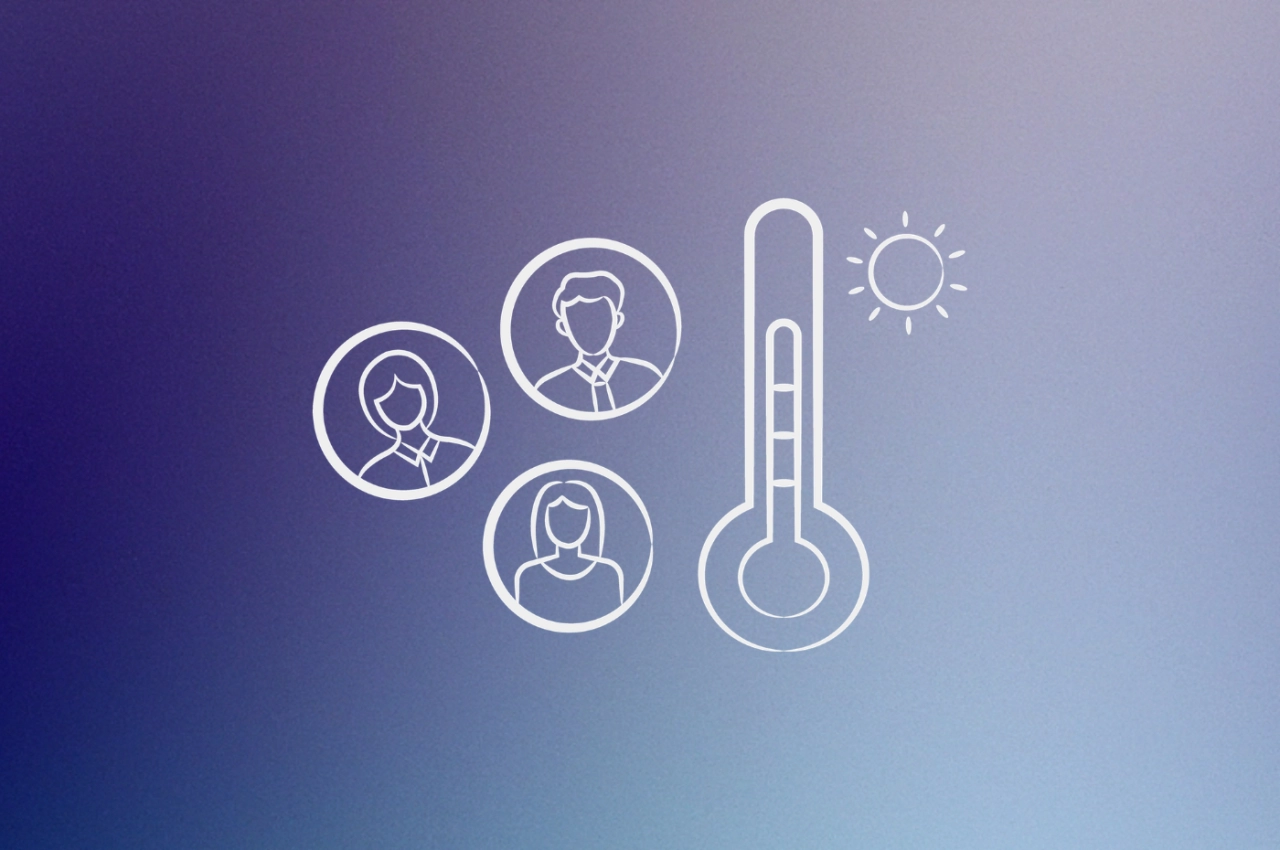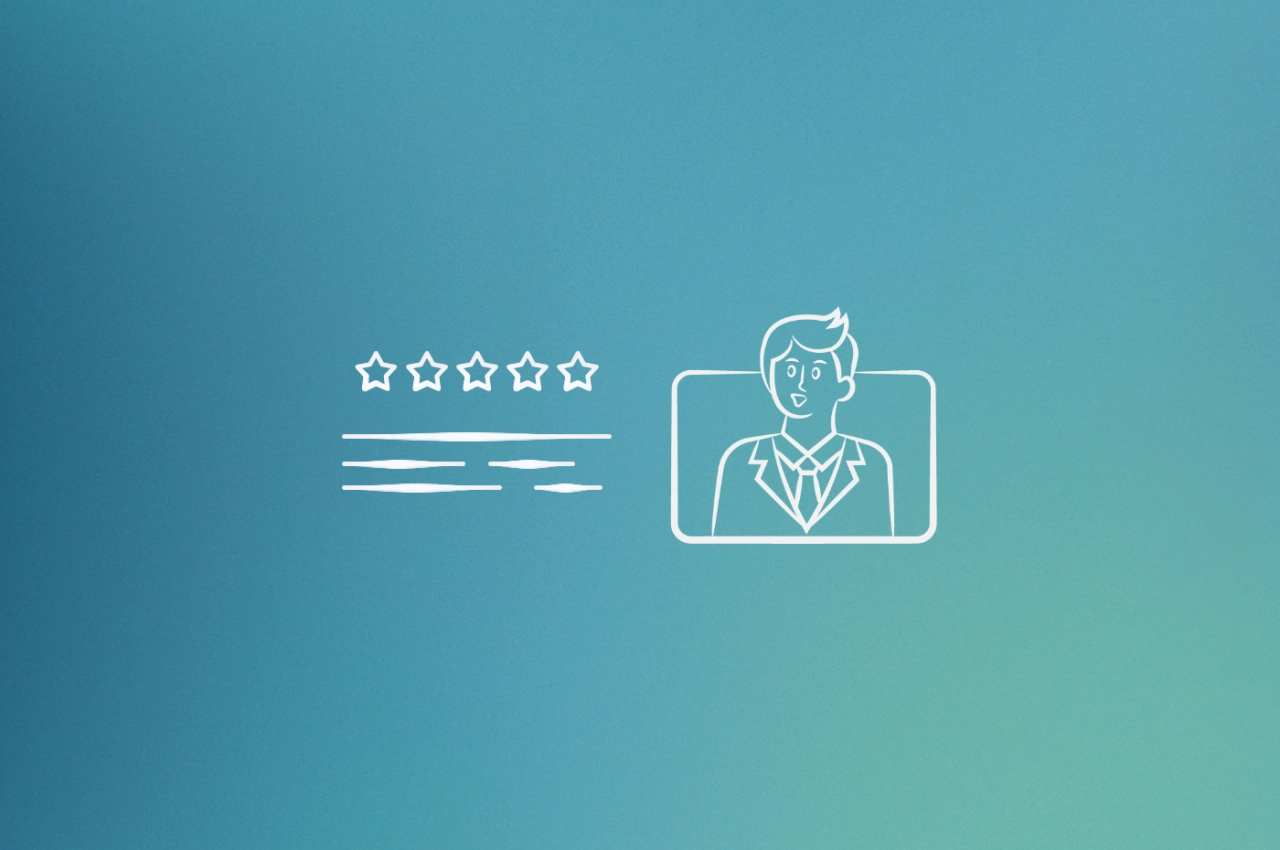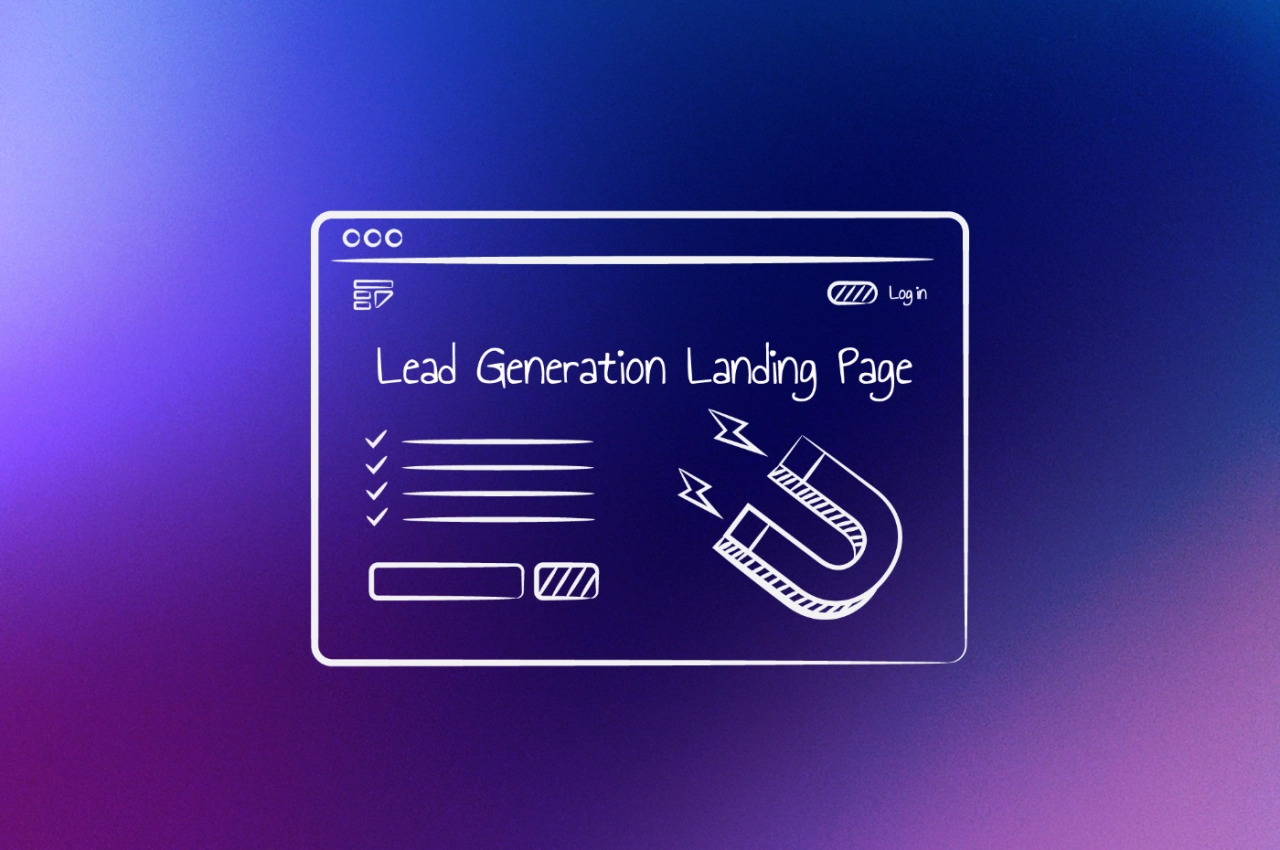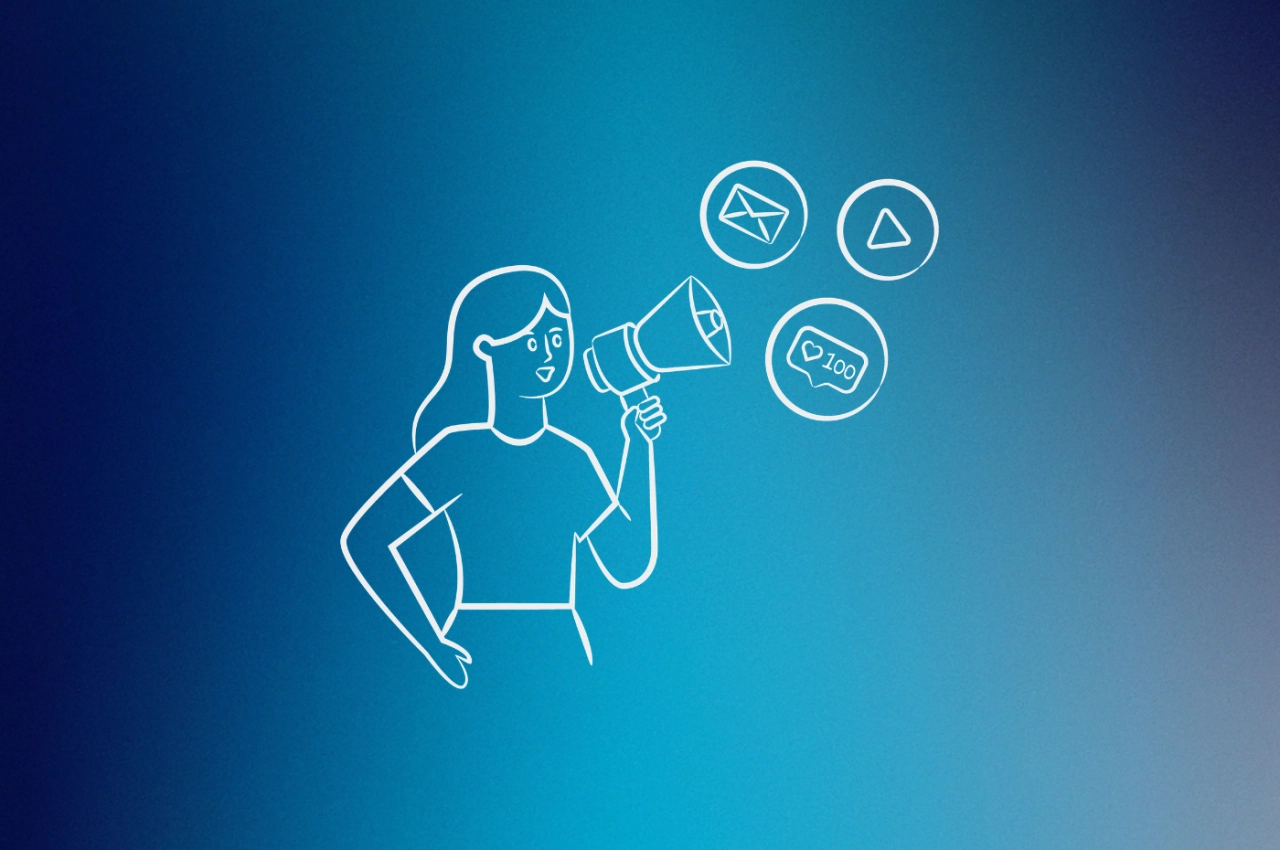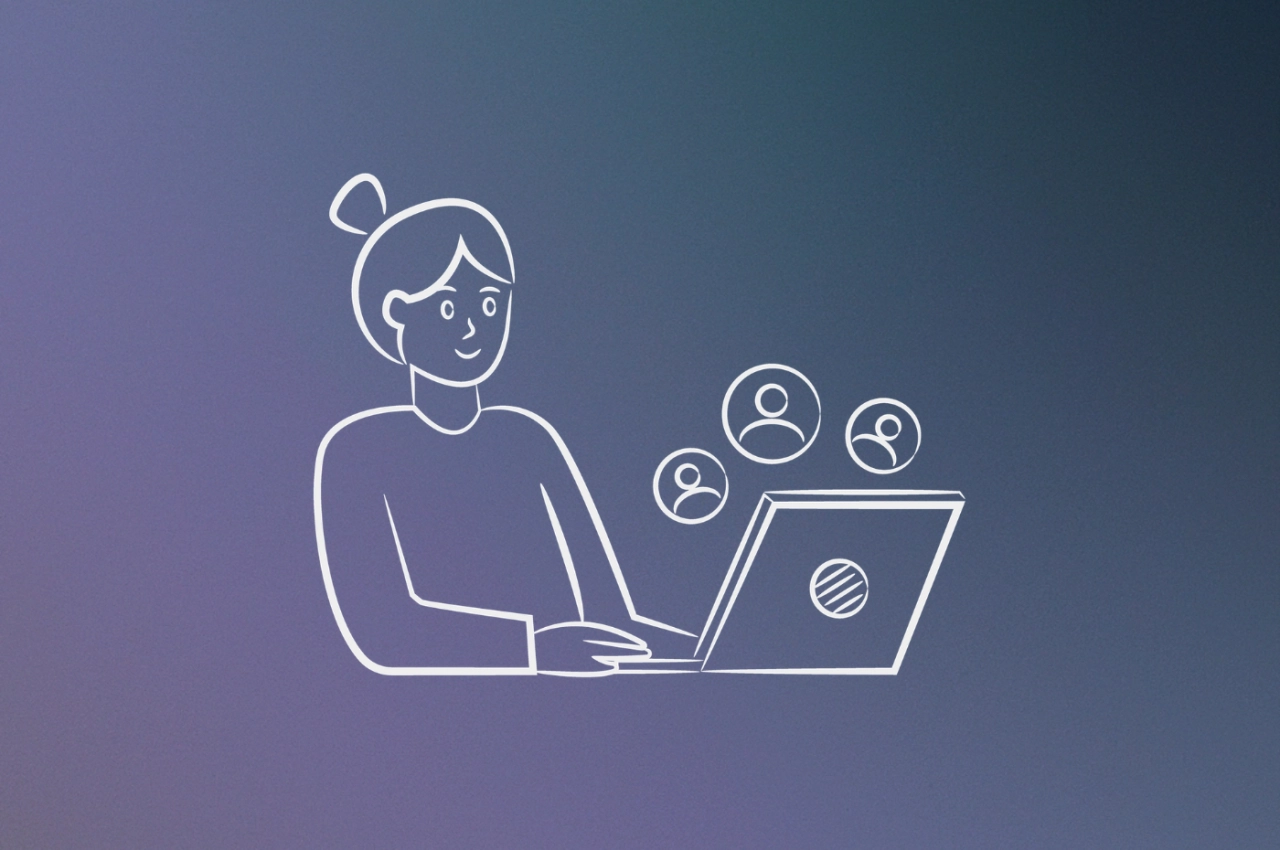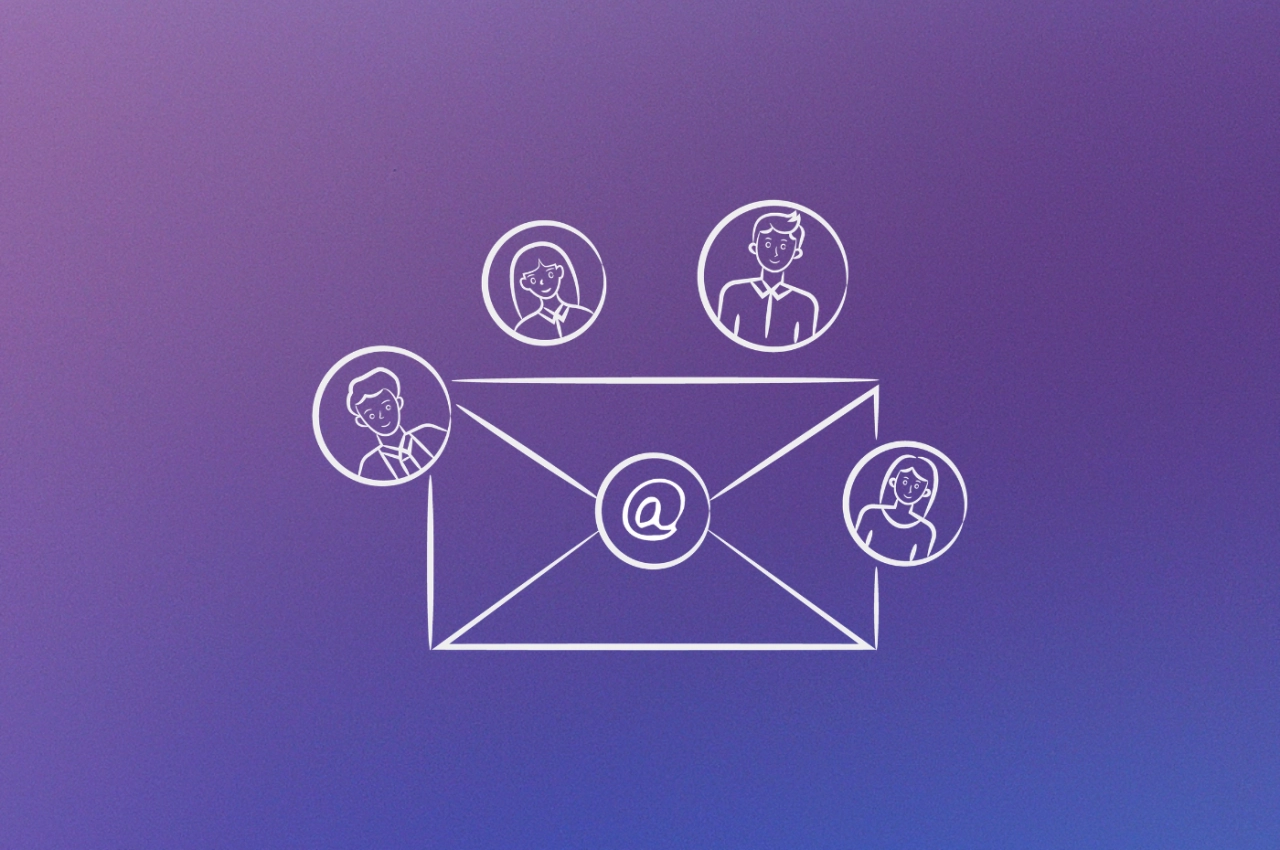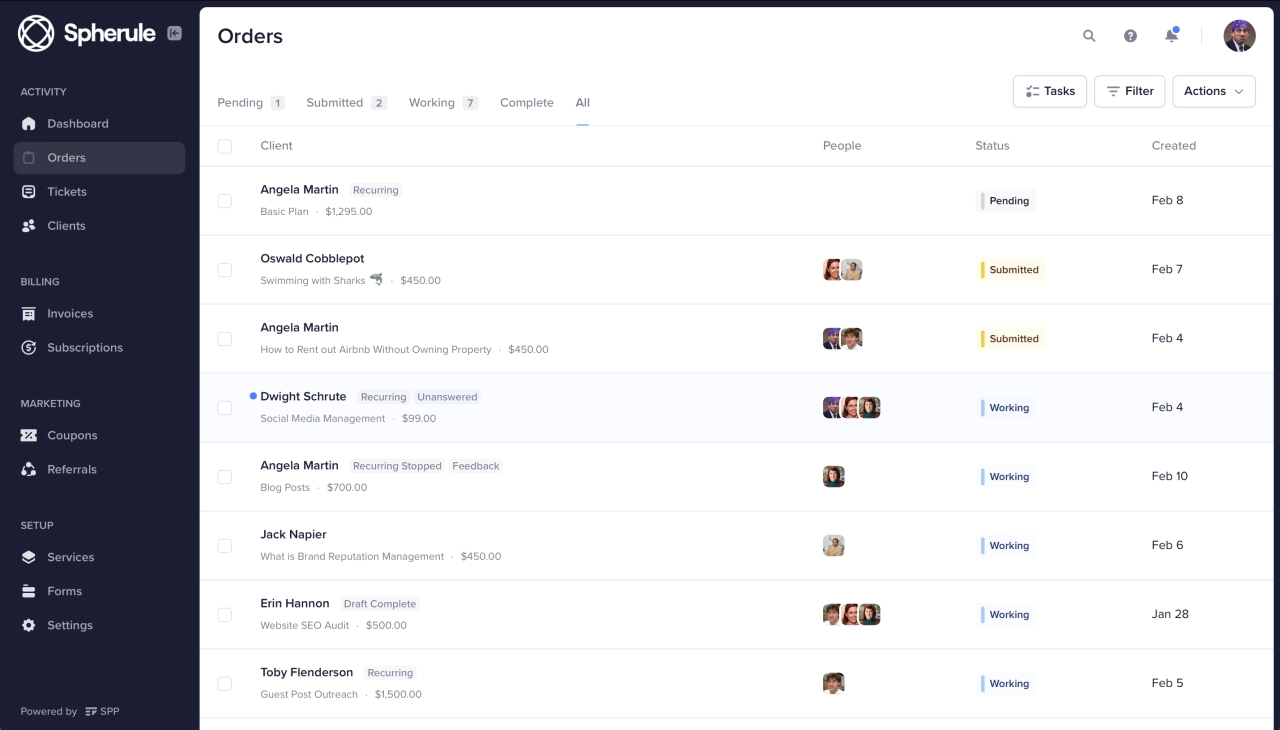- Industry benchmarks suggest cold leads typically convert at 1-5% over 90-180 days, warm leads at 10-25% in 30-60 days, and hot leads at 60-80% in 7-21 days.
- Most agencies misclassify leads—demo requests are warm (not hot), referrals are warm (not cold), single website visits are cold (not warm).
- Run a 5-minute pipeline audit to identify your biggest gap: volume (need cold prospecting), conversion (fix warm nurturing), or speed (respond faster to hot leads).
Most agencies treat all leads the same way—pitching cold prospects who aren’t ready, neglecting warm leads who need nurturing, or responding too slowly to hot leads comparing vendors right now. The result: longer sales cycles, lower conversion rates, and missed revenue.
Lead temperature changes this. When you match your approach to each lead’s readiness, you stop wasting time on prospects who need more nurturing and start closing the ones who are actually ready to buy.
Marketing research commonly suggests that only 3–5% of your prospects are ready to buy at any given moment. The other 95–97% are somewhere in the cold-to-warm spectrum. The agencies hitting consistent revenue targets work all three types systematically—not just the handful ready to sign contracts today.
This guide shows you how to identify each lead type, what conversion rates to expect, and how to build a balanced pipeline that drives predictable revenue growth.
Quick start: identify your lead type
I know you’re busy, so run this 5-minute audit to understand what you’re actually working with.
The 5-minute pipeline audit
Step 1: Categorize your leads by last interaction date:
0-7 days = hot
8-60 days = warm
60+ days or never engaged = cold
Step 2: Calculate conversion rates for each group over the last 90 days:
If you closed 2 deals from 50 warm leads over the last 90 days, that’s a 4% warm lead conversion rate. Run this calculation for each category.
Step 3: Identify your biggest gap:
Low total volume = you need more cold prospecting
Warm leads converting poorly = your nurturing process needs work
Hot leads going cold = you’re responding too slowly
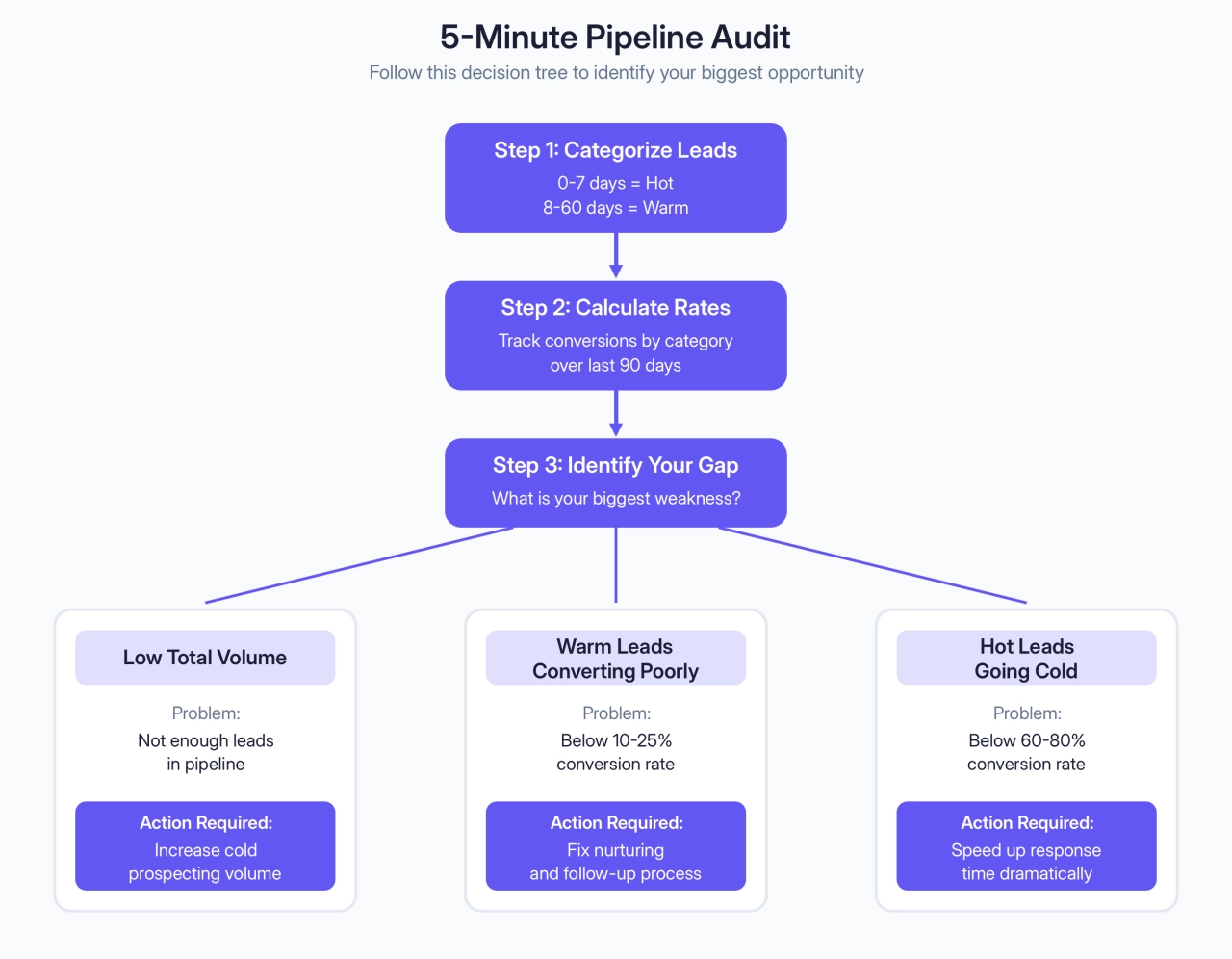
Starting from zero? If you have fewer than 20 leads total, skip the percentages and focus on your immediate network first. Reach out to 10 past colleagues or clients asking for specific intros. Get your first 5–10 warm leads through referrals, then come back to this audit when you hit 20+ leads.
What these numbers mean
If you have mostly cold leads:
Your sales cycle will typically run 90–180 days with conversion rates in the 1–5% range. This is normal for early-stage agencies building awareness from zero. Cold prospecting fills your future pipeline, but don’t expect immediate revenue.
If you have mostly warm leads:
You’re looking at 30–60 day sales cycles with conversion rates typically in the 10–25% range. These prospects already know who you are—focus your sales team’s attention here. Warm lead nurturing generally delivers significantly better ROI than cold prospecting.
If you have mostly hot leads:
Your sales cycle should be 7–21 days with conversion rates typically in the 60–80% range. At this stage, speed matters more than anything else. Response time within the first hour can increase conversions by 391% compared to waiting just 2+ minutes.
The problem most agencies face: they don’t actually have hot leads—they have warm leads they’re miscategorizing. More on that distinction below.
The lead temperature scale
Lead temperature measures purchase readiness—how much prospects know about your agency and how close they are to buying. For a complete overview of lead generation fundamentals, see our guide to what lead generation is.
The lead lifecycle explained
Cold leads don’t know you exist; warm leads have engaged with your content but haven’t committed; hot leads are comparing proposals and ready to sign within days or weeks.

Cold leads have no awareness of your brand and no expressed interest in your services. They’re potential customers based on fit (industry, company size, budget), but they haven’t engaged with you yet.
Warm leads know who you are and have shown some interest. They’ve visited your website, downloaded a resource, or attended your webinar. They’re familiar with your value proposition but haven’t committed to a purchase timeline.
Hot leads are actively evaluating solutions and ready to buy. They’re comparing vendors, requesting proposals, or asking detailed questions about implementation. The purchase decision is imminent—often within days.
Why lead classification matters for agencies
Understanding lead temperature helps you allocate resources. Cold leads require patient, education-focused nurturing campaigns; warm leads benefit from targeted case studies and social proof; hot leads need immediate sales attention and personalized proposals.
The ROI difference is measurable: agencies often report 30-50% improvement in conversion rates and 20-40% reduction in sales cycle length when matching tactics to lead temperature.
Here’s how the three lead types compare. Use this to set realistic expectations and allocate your team’s time:
Factor | Cold Leads | Warm Leads | Hot Leads |
|---|---|---|---|
Brand Awareness | None | Familiar with brand | Actively evaluating |
Engagement Level | Zero interaction | Some engagement | High engagement |
Sales Cycle | Typically 90-180 days | Typically 30-60 days | Typically 7-21 days |
Conversion Rate | Industry benchmark: 1-5% | Industry benchmark: 10-25% | Industry benchmark: 60-80% |
Primary Tactic | Education & awareness | Nurturing & proof | Personalization & speed |
Resource Investment | Low cost, high volume | Medium cost, medium volume | High cost, low volume |
Cold leads: zero brand awareness
Cold leads are your biggest potential market and your hardest conversion challenge. These prospects fit your ideal customer profile but have never heard of your agency.
What defines a cold lead
A cold lead is someone who fits your target criteria but has never heard of you. No relationship, no engagement, zero brand awareness. You’re initiating contact, not responding to their inquiry.
This could be through cold email, phone calls, paid advertising, or networking events—any channel where you’re reaching out first.

No brand awareness: Cold leads haven’t heard of your agency. Every interaction starts with basic education about who you are and why they should care.
Zero engagement history: There’s no prior interaction to build on. No website visits, no opened emails, no attended webinars. Building trust takes time.
Longest sales cycle: Converting a cold lead typically takes 90-180 days, sometimes longer for complex services or larger deals. Building awareness and credibility from zero takes time.
Lowest conversion rates: Industry benchmarks suggest 1-5% of cold leads eventually convert. Cold prospecting is a volume game. The key is keeping acquisition costs low enough that even a 2% conversion rate delivers positive ROI.
How to identify cold leads
Cold leads are straightforward to identify—they’re the prospects who’ve never engaged with your business:
never visited your website
never opened your emails
never responded to outreach
found via prospecting tools (LinkedIn Sales Navigator, ZoomInfo, Apollo.io)
met at networking events but no follow-up interaction
Where cold leads come from
Cold leads enter your pipeline through these main channels:
Paid advertising on platforms like LinkedIn, Google Ads, and Facebook allows precise targeting based on job title, industry, and company size. You can reach thousands of qualified prospects who’ve never heard of you. Cold advertising campaigns on LinkedIn typically see click-through rates in the 0.5-2% range.
Networking events put you in front of cold leads in warmer contexts. Industry conferences, local business meetups, and professional association events gather your target prospects where they’re more receptive to new connections. The challenge: most agencies fail at systematic follow-up after the event.
Content marketing attracts cold leads during their research phase. Blog posts, videos, and guides that address prospect challenges generate inbound traffic from completely cold audiences. For detailed content strategies, see our guide to content marketing lead generation.
Prospecting lists from B2B data providers like ZoomInfo, Cognism, or Apollo.io offer immediate access to thousands of prospects matching your criteria. However, everyone else has access to the same lists, so competition for attention is fierce.
Some agencies buy contact lists instead of building them manually. It’s faster but usually lower quality—you’re working the same lists as everyone else. Mix purchased lists with your own research if you go this route.
Real example: cold email follow-up persistence
Ambition, a sales productivity software company, ran a 6-week cold email campaign targeting 578 VPs of Sales and Sales Operations executives. They documented the full campaign with surprising results.
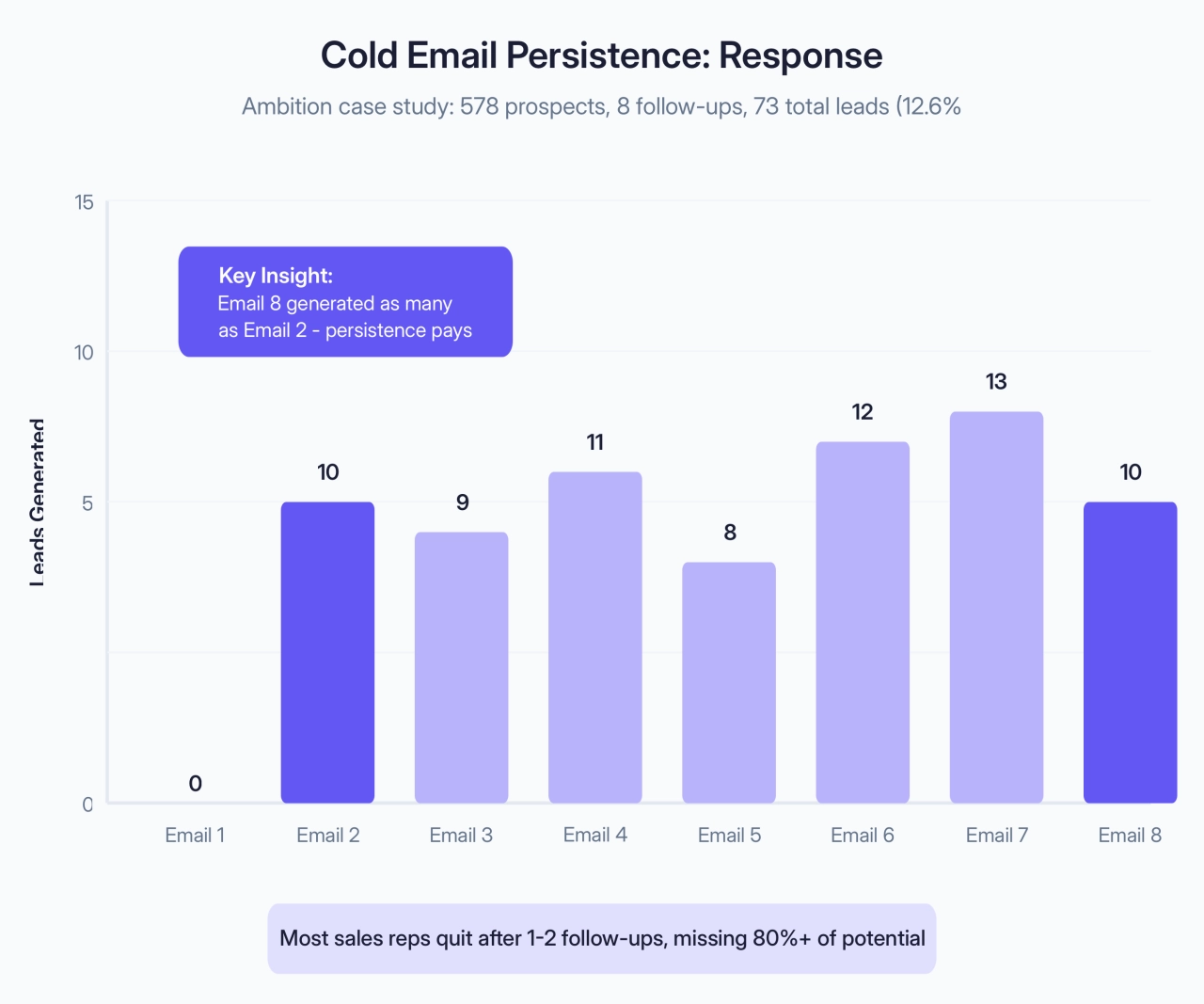
Zero prospects replied to the initial email. But Ambition kept following up, spacing emails a week apart across eight total touchpoints.
Results after 8 follow-ups:
73 total leads generated (12.6% response rate)
the 8th follow-up email generated as many leads as the 2nd
no single email generated more than 18% of total leads
half of recipients opened the initial email, but responses came throughout the entire sequence
The distribution was revealing: no single touchpoint dominated. Responses came steadily from email 2 through email 8, with later emails performing just as well as early ones.
According to Ambition’s analysis, persistence mattered most. Most sales reps follow up once or twice, missing 80%+ of potential responses that happen at touchpoints 4–8.
Common cold lead challenges
Time and effort: Manually verifying and qualifying cold leads drains resources. The research and outreach process is labor-intensive before you even know if a prospect is a good fit.
High rejection rates: 95–99% of properly targeted cold leads won’t convert. You need volume high enough that the 1–5% who do convert justify the effort. This can be emotionally draining for sales teams facing constant rejection.
Trust and credibility: Cold leads often view unsolicited contact as intrusive. Building trust quickly is essential to overcome their natural skepticism.
Long time to ROI: You might spend 3–6 months on cold outreach before seeing meaningful revenue. This makes cold lead generation better suited for agencies with stable cash flow who can invest in future pipeline rather than needing immediate revenue.
If you don’t have 10–15 hours/week for systematic cold prospecting, see our guide on outsourced lead generation for hiring SDRs or agencies to handle this.
When to abandon cold leads
Stop outreach after 6–8 touchpoints without response. If a cold lead hasn’t engaged after multiple emails, calls, or LinkedIn messages over 2–3 months, they’re unlikely to engage later.
Poor fit becomes apparent quickly through research or brief conversations. No budget, wrong decision maker, or doesn’t need what you offer? Don’t force it. Focus energy on better-fit prospects.
Immediate opt-outs or negative responses should end outreach instantly. Continuing after someone asks to be removed damages your reputation and potentially violates regulations.
Warm leads: engaged but not committed
Warm leads are your highest-ROI opportunity. They know who you are and have shown interest. Convert them right, and you’ll see 10–25% close rates with 30–60 day sales cycles—significantly better than cold leads.
What defines a warm lead
A warm lead knows about your agency and has demonstrated interest—downloaded a resource, attended a webinar, or engaged with your content. They’re familiar with your value proposition but haven’t committed to a purchase.
Unlike cold leads, warm prospects respond to your outreach. Industry benchmarks show they typically convert at 10–25% versus cold leads’ 1–5%, and close in 30–60 days instead of 90–180.
Brand awareness established: Warm leads recognize your agency name and have basic familiarity with what you do. They might have visited your website multiple times, read your content, or heard about you from a referral. This awareness means you can skip basic education and move to value demonstration.
Some engagement history: There’s a track record of interaction to build on. Maybe they opened several emails, downloaded a case study, or attended your webinar. Each interaction strengthens the relationship and gives you data about their interests.
Medium sales cycle: Converting a warm lead typically takes 30–60 days. They need time to evaluate whether you’re the right fit, compare alternatives, and build internal consensus. Because they already understand your value proposition, this process moves faster than with cold leads.
Higher conversion rates: Warm leads typically convert at 10–25%, depending on lead quality and your follow-up process. This makes them significantly more valuable than cold leads on a per-lead basis, though the total volume is usually smaller.
How to identify warm leads
Here’s how to spot warm leads:
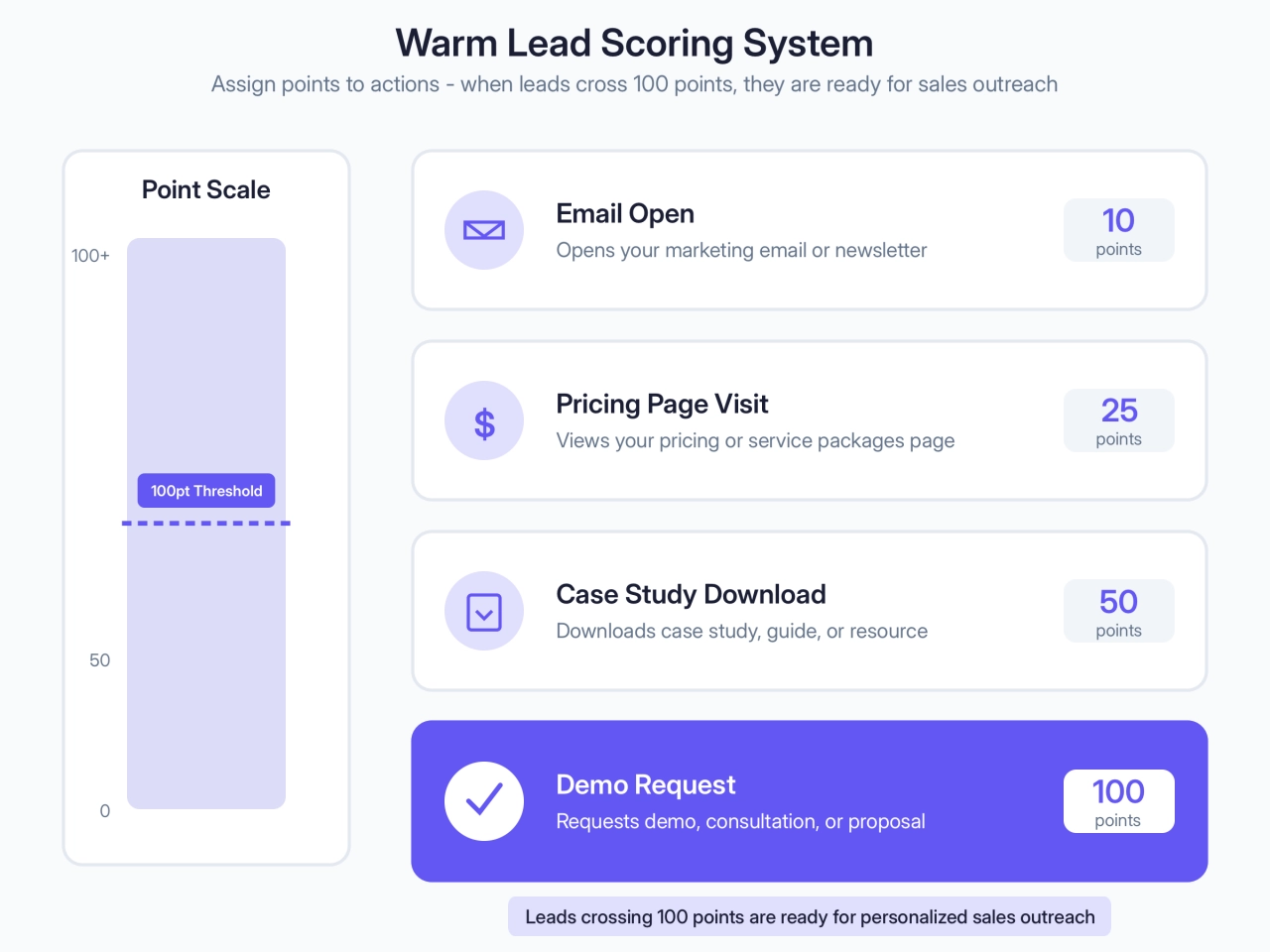
Email engagement: Open rates, click-throughs, and content downloads indicate interest. Someone who opens every SEO email but ignores paid ads content is telling you what they need.
Website activity: Pages visited, time on site, and return frequency matter. Multiple visits to your pricing page signal warming interest. Track this in your CRM.
Content downloads: Case studies, guides, and templates show they’re researching solutions. The more they download, the warmer they get.
Event attendance: Webinar participants and workshop attendees have invested time learning about your expertise. This separates them from casual browsers.
Lead scoring signals: Assign points to actions—10 for email open, 25 for pricing page visit, 50 for case study download, 100 for demo request. When leads cross your threshold (say, 100 points), they’re warm enough for direct sales outreach.
To score leads better, enrich your CRM data with company info and tech stack details. You can’t accurately judge if someone’s warm or cold when half your contact records are missing basic information like job title or company size.
Cold vs warm: key differences
Your approach changes completely between cold and warm leads:
Dimension | Cold Leads | Warm Leads |
|---|---|---|
Awareness | No knowledge of your agency | Familiar with brand and services |
Trust Level | Zero established credibility | Some credibility from prior interactions |
Communication | One-way (you’re educating) | Two-way (they’re engaging back) |
Sales Approach | Education and awareness building | Value demonstration and social proof |
Response Rate | Typically 1–5% (outbound tactics) | Typically 25–40% (targeted nurturing) |
Personalization Needs | Basic (industry, role, company) | Deep (specific interests, engagement history) |
Timeline Pressure | Low (building long-term pipeline) | Medium (they’re evaluating now) |
Objections | “Why should I care?” | “Why you over competitors?” |
You have to get inside the mind of the person you’re emailing, right? Let’s say you’re emailing agency founders. These guys are, they’re too busy to even do their own marketing… They don’t even have 30 minutes to commit to doing marketing every week. Why would they respond to this?
 Alex Berman,
X27
Alex Berman,
X27
With cold leads, you’re earning attention. With warm leads, you’re earning trust and demonstrating fit.
Why warm leads matter for agency growth
Warm leads know your value proposition but haven’t chosen a vendor yet. They’re ready to evaluate, not just learn.
They typically convert at 10–25%, which is significantly higher than cold leads while requiring far less sales effort than starting from zero awareness. They also move through your pipeline faster—30–60 days versus 90–180 for cold leads.
Focus here first. You’ve already paid to generate this interest through content, advertising, or outreach. Don’t waste it with poor follow-up or generic messaging.
Real example: why response speed matters
Research from Chili Piper analyzing thousands of B2B sales interactions found that response time directly impacts conversion probability:
Response time impact on conversions:
Respond within 1 minute: 391% higher conversion vs waiting just 2+ minutes
Respond within 5 minutes: 100x more likely to connect than with a 30+ minute delay
Respond within 5 minutes: 21x more likely to qualify the lead vs waiting 30+ minutes
Yet the average B2B company takes 42 hours to respond to new leads, and 38% never respond at all.
Industry benchmarks for comparison:
Telecommunications: 16 minutes average response time
Small companies (1-300 employees): 48 minutes
Medium companies (301-2,500 employees): 1 hour 38 minutes
Healthcare: 2 hours 5 minutes
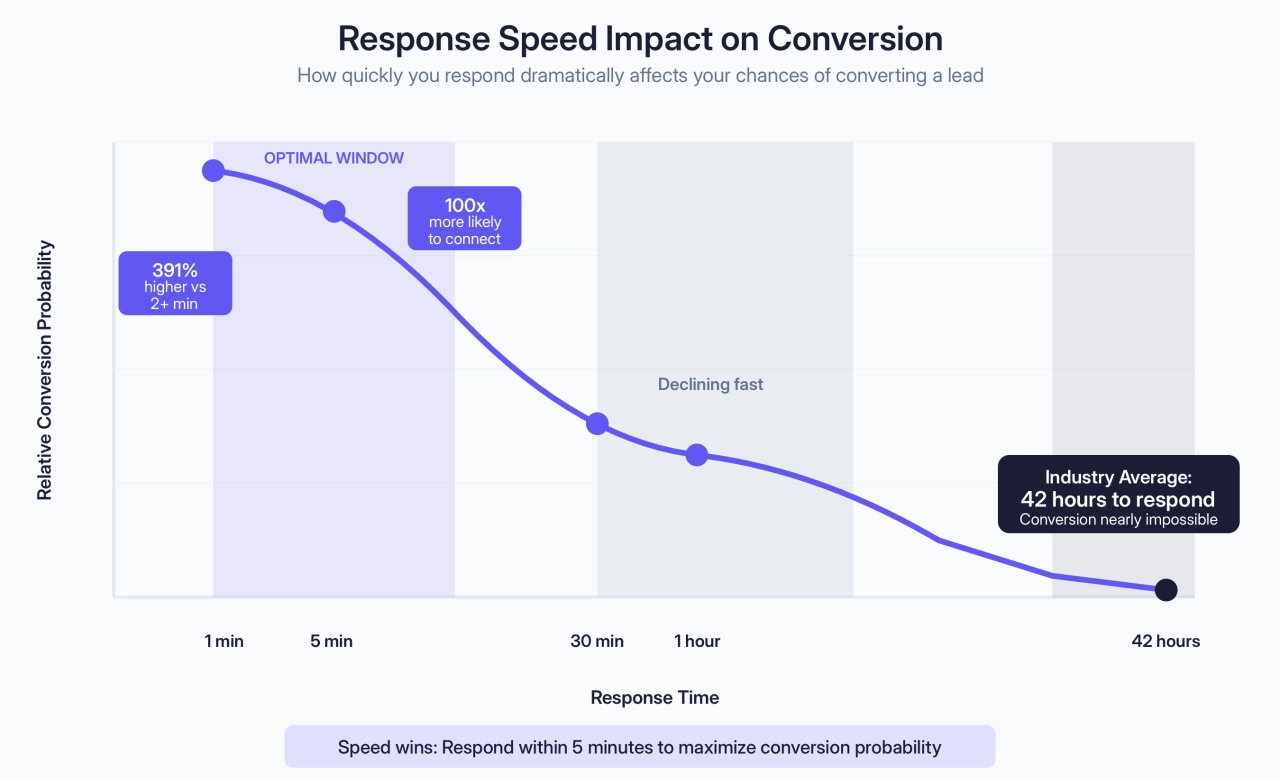
When three agencies compete for the same client with similar proposals, the one that responds to the initial inquiry fastest typically wins—regardless of price differences. Speed signals prioritization and professionalism. Slow response times tell prospects they’re not important.
5 common warm lead mistakes
Poor timing and cadence: Contacting leads too frequently creates pressure. Waiting too long lets interest cool—prospects forget about you or move forward with competitors. A general guideline: follow up every 5–7 days if they’re early-stage warm (just downloaded content), and every 3–4 days if they’re late-stage warm (visited pricing page multiple times).
Generic messaging: Sending one-size-fits-all content that ignores specific pain points or previous interactions wastes the engagement you’ve already earned. Someone who downloaded your SEO guide wants SEO-specific follow-up, not generic “here’s what we do” emails.
Premature sales pushes: Rushing to close before leads are ready creates resistance and damages trust. A warm lead who downloaded one blog post isn’t ready for a proposal. Watch for buying signals—multiple pricing page visits, case study downloads, demo attendance—before pushing for a sale.
Data silos: Losing critical lead information when transitioning between marketing and sales teams kills momentum. If engagement data doesn’t transfer to sales, your reps treat warm leads like cold prospects and start from zero. Integrate your marketing automation and CRM so sales teams see the complete interaction history.
Neglecting mid-funnel content: Creating plenty of awareness content (top of funnel) and some decision content (bottom of funnel), but missing the evaluation content that warm leads need most. Build comparison guides, detailed case studies, ROI calculators, and implementation roadmaps. Warm leads are asking “which agency should I choose?”—your content should answer that question.
We use a lot of inbound marketing techniques to ensure that we have a really healthy pipeline. This includes having a newsletter, both for our current clients and potential clients. It means setting up or making it very easy to set up calls and talk with us or anyone on our staff…
 Tim Akers,
Akers Digital
Tim Akers,
Akers Digital
For detailed warm lead conversion tactics, email templates, and automation strategies, see our complete guide to email lead generation.
Hot leads: ready to buy now
Hot leads are ready to buy now. They’re comparing vendors, requesting proposals, and making decisions within days. Convert them fast—60–80% close rates are standard when you respond with speed and precision.
What defines a hot lead
A hot lead is a potential customer who’s ready to buy now. They’ve moved past awareness and evaluation—they’re actively comparing vendors, requesting proposals, and asking specific questions about pricing, implementation timelines, and deliverables.
Hot leads typically convert at 60–80% and close in just 7–21 days, making them immediate revenue opportunities. The purchase decision is imminent, often within days.
What separates hot leads: urgency and specificity. Hot leads aren’t browsing—they’re buying. They ask detailed questions about contracts, start dates, and payment terms. They’re not wondering if they need help; they’re choosing which agency to hire.
High purchase intent: Hot leads are past awareness and evaluation—they’re in decision mode. They’ve identified their problem, researched solutions, and determined that an agency like yours is the answer. Now they’re choosing which agency specifically.
Shortest sales cycle: Converting a hot lead typically takes 7–21 days. They’re moving fast because they have a pressing need or a deadline. Internal approvals are often already secured, and they’re ready to start quickly.
Highest conversion rate: Hot leads typically convert at 60–80% if you respond appropriately. At this stage, losing deals is usually due to poor responsiveness, pricing misalignment, or lack of trust rather than fit issues.
How to identify hot leads
Four signs a lead is actually hot:

High engagement intensity: Hot leads interact with your business multiple times in a short period. They might visit your pricing page three times in two days, download several case studies, and attend your next webinar—all within a week. Watch for velocity changes. A prospect who suddenly visits your pricing page three times in two days after months of silence is entering buying mode.
Authority to make purchase decisions: Hot leads are either the decision maker or very close to them. They ask questions about contracts, payment terms, and implementation rather than general “how does this work?” questions. In B2B contexts, look for senior titles (Director, VP, C-level) or clear signals they’re involved in procurement: “I’m evaluating options for our Q1 marketing budget” or “We need to choose a vendor by end of month.”
Budget confirmed: Hot leads discuss pricing specifics rather than asking if you have packages. They might say “We have $50K budgeted for this” or “What can we get for around $X per month?” Budget discussions mean they’ve moved past internal approvals and are ready to spend.
Clear, near-term timeline: Hot leads mention specific deadlines: “We need to launch by Q3,” “Our current contract ends in 30 days,” “We’re hoping to start in 2–3 weeks.” Time-bound language signals urgency.
Hot leads vs qualified leads
No. They overlap but aren’t identical.
Qualified leads meet your criteria: right budget, timeline, authority, and need. All hot leads are qualified, but qualified leads aren’t always hot—they might still be cold or warm.
Marketing Qualified Leads (MQLs) meet specific engagement criteria suggesting they’re ready for sales outreach. They might have downloaded multiple resources, attended events, or engaged heavily with content. However, they need more time and further nurturing. MQLs can be warm or hot depending on their readiness to buy.
Sales Qualified Leads (SQLs) have been vetted by sales and confirmed to have genuine purchase intent, budget, authority, and timeline. They’ve requested a service demo, asked about pricing, or spoken with your sales rep. SQLs are almost always hot leads.
Qualification measures fit and readiness (can they buy?). Temperature measures urgency (will they buy soon?). A lead can be perfectly qualified but cold (right fit, no urgency). Or hot but unqualified (urgent need, unclear budget).
For practical purposes, treat hot leads as your highest priority regardless of official qualification status. Someone requesting a proposal today is more important than someone who’s perfectly qualified but not yet ready to buy.
What kills hot lead conversions
Generic proposals: Hot leads expect tailored communication. Reference their specific situation in every email, call, and proposal. Address their specific challenges by name, tailor case studies to their exact industry, and customize proposals to their stated budget and timeline.
Missing social proof: Hot leads need confidence you’ll deliver. Provide references from similar clients, offer to connect them with current customers, and proactively address common concerns. Share case studies, reviews, and testimonials from satisfied customers.
Lack of transparency: If you can’t meet their timeline, say so rather than overpromising. If their budget is below your typical minimum, discuss options honestly rather than forcing a poor-fit proposal.
Slow response times: Every hour of delay decreases conversion probability. Set up alerts in your CRM for high-intent actions like demo requests and pricing inquiries. These require same-day response, ideally within 60 minutes.
Hot leads need fast response times, not a 24-hour follow-up cadence. Breakcold and similar tools automatically flag your highest-intent prospects so sales can jump on them immediately.
Real example: systematic cold-to-hot nurturing
LeadFuze, a lead generation software company, grew from zero to $30,000/month in revenue within 12 months using a systematic approach that moved cold leads to hot status predictably.
Founder Justin McGill built a 4-email sequence he called the “QVC Formula” (Question, Value proposition, Call to action):
Email 1: Initial outreach with personalized question, clear value prop, and specific CTA
Email 2: Relevant case study showing results for similar company
Email 3: Additional value-add (helpful blog post, news article, or second case study)
Email 4: Break-up email (“This is my last follow-up—let me know if you’d like to connect”)
The break-up email consistently generated the highest response rate. Prospects who ignored the first three emails often replied when they realized this was their last chance to engage.
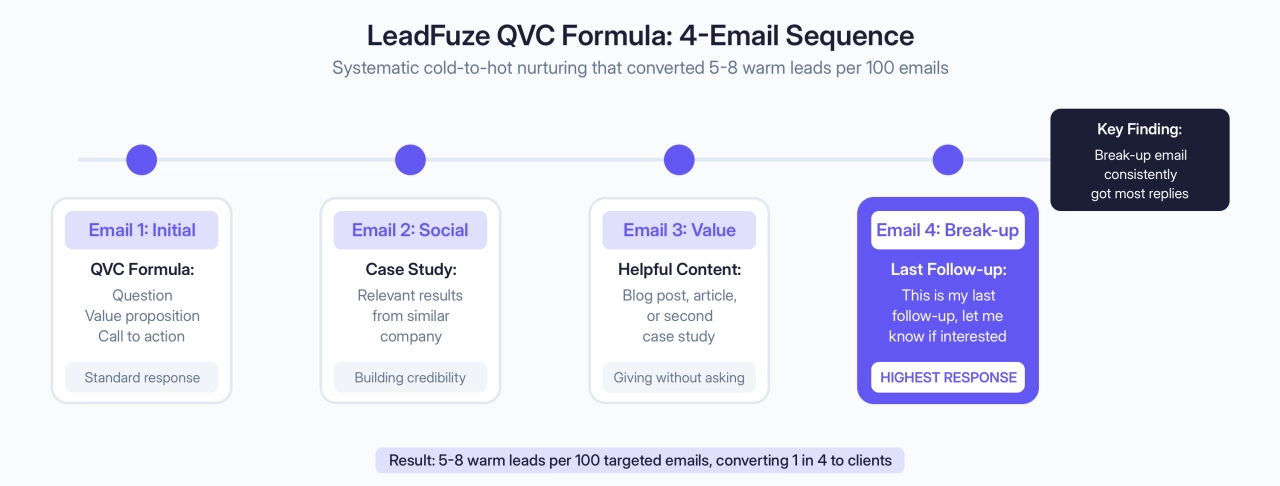
By automating this sequence and maintaining consistent volume, LeadFuze built predictable pipeline. They could forecast that every 100 targeted emails would generate 5-8 warm leads, and every 4 warm leads would convert to 1 client.
Hot leads don’t appear randomly. They’re the result of systematic cold prospecting and warm lead nurturing executed consistently over time.
Are you misclassifying your leads?
Most agencies get lead temperature wrong. Here are the most common mistakes:
Demo request ≠ hot lead
Someone filling out a “request a demo” form is warm, not hot—unless they mention specific budget and timeline in the request. Hot leads are already comparing vendors and asking about start dates. Demo requests need nurturing before they’re ready to buy.
Single website visit ≠ warm lead
A prospect who visited your website once is still cold—unless they engaged with content (downloaded something, watched a video, read multiple blog posts). Warm leads have a pattern of engagement, not a single touchpoint.
Referral from client ≠ cold lead
When a current client refers someone, that prospect is automatically warm, not cold. Trust transfers through the referral. They already have positive awareness of your agency, even if they haven’t engaged directly yet.
Why this matters:
Misclassification kills conversions. Treat a warm lead like they’re hot (aggressive sales push), and you’ll lose the deal. Treat a hot lead like they’re warm (slow follow-up), and they’ll choose your competitor.
Run your 5-minute pipeline audit again, but this time check: are you categorizing based on their actual behavior, or what you hope they are?
Strategic lead type comparison
Here’s the complete comparison. Use this to allocate resources and set realistic expectations:
Dimension | Cold Leads | Warm Leads | Hot Leads |
|---|---|---|---|
Brand Awareness | No knowledge of your agency | Familiar with brand and services | Actively evaluating your agency |
Engagement Level | Zero prior interaction | Some engagement (content, events, emails) | High engagement (proposals, pricing, detailed questions) |
Sales Cycle Length | Typically 90-180 days | Typically 30-60 days | Typically 7-21 days |
Typical Conversion Rate | Industry benchmark: 1-5% | Industry benchmark: 10-25% | Industry benchmark: 60-80% |
Primary Challenge | Getting attention | Building trust and demonstrating value | Closing quickly and effectively |
Best Tactics | Cold outreach, content marketing, ads | Nurturing sequences, social proof, value demos | Fast response, personalization, trust-building |
Communication Style | Educational (teaching them about their problem) | Consultative (showing how you solve it) | Transactional (proposal, pricing, logistics) |
Resource Investment | Low cost per lead, high volume needed | Medium cost per lead, moderate volume | High cost per lead, low volume needed |
Success Metrics | Response rate, engagement rate | MQL-to-SQL conversion, nurture effectiveness | Close rate, time-to-close, deal size |
Primary Risk | Wasting time on poor-fit prospects | Losing leads to competitors during nurturing | Losing deals due to slow response or pricing issues |
Pipeline balance recommendations
Many agencies find that a balanced pipeline includes all three lead types in roughly these proportions:
50-60% cold leads provide pipeline volume and future growth. These take the longest to convert but represent your largest potential market. Consistent cold prospecting ensures you’re never dependent on just a few hot opportunities.
25-35% warm leads are your conversion engine. These prospects are aware and engaged but need nurturing. Focus significant resources here—converting warm leads to hot leads and then to customers typically delivers strong ROI.
10-20% hot leads are immediate revenue opportunities. These close fast but represent smaller volume. Prioritize them for sales team attention, but don’t build your entire pipeline on hot leads alone—the volume is too unpredictable.
My experience has been a lot of agency owners, when you talk about Biz Dev, their natural response is, ’Well, we get so much work by referral, we don’t need anything,’ but the truth is, then, what that means is whatever comes through the door, you have to take, whether it’s a good fit or not.
 Drew McLellan,
Agency Management Institute
Drew McLellan,
Agency Management Institute
The exact mix depends on your agency’s growth stage:
Early-stage agencies often run roughly 70% cold, 25% warm, 5% hot (building awareness)
Established agencies often run roughly 40% cold, 40% warm, 20% hot (optimizing conversion)
Scaling agencies often run roughly 30% cold, 45% warm, 25% hot (capitalizing on brand equity)
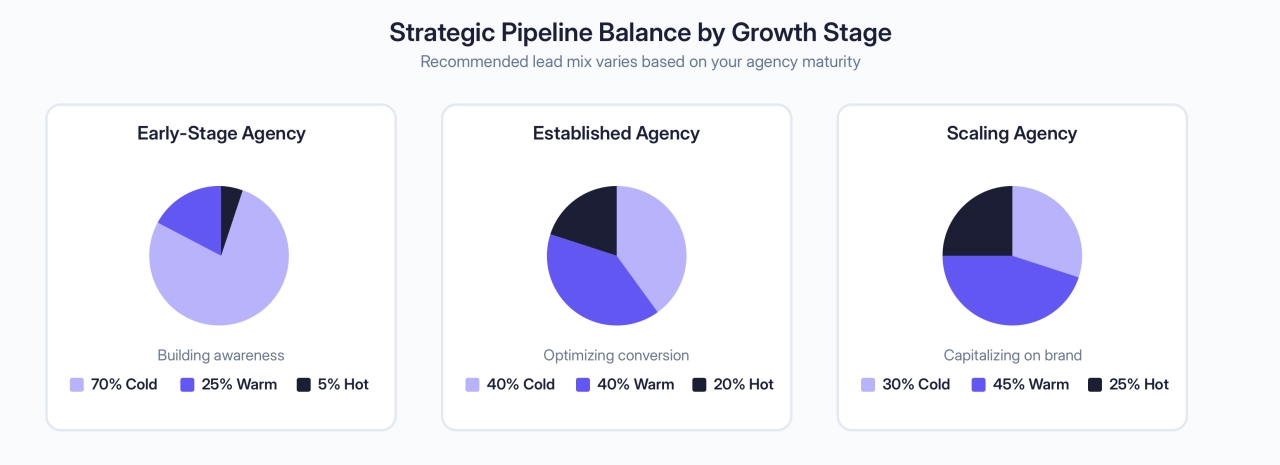
Small pipeline (<50 leads)? Don’t stress about exact percentages yet. Focus on consistent activity: add 10 cold leads/week, nurture the warm ones you have, and respond fast to any hot leads. Percentages matter when you hit 100+ leads.
For detailed strategies on building a balanced pipeline, see our complete guide to B2B lead generation.
Frequently asked questions
What’s the main difference between cold, warm, and hot leads?
Cold leads have never heard of you. Warm leads know who you are and have engaged with your content. Hot leads are comparing vendors and buying within days. The tactics that work for cold leads will kill hot lead conversions—and vice versa.
How long does it typically take to convert each lead type?
Cold leads take 90-180 days, warm leads take 30-60 days, and hot leads close in 7-21 days. These timelines vary by service complexity and deal size, but the relative speed differences hold true across most agency services.
Should my agency focus more on cold or warm leads?
Prioritize warm leads for ROI—they typically convert at 10-25% vs cold leads’ 1-5% and close faster. However, maintain cold prospecting to fill your pipeline with future warm leads, or your warm lead pool will eventually deplete. See our outbound lead generation guide for tactics.
How do I move cold leads to warm status?
Consistent value delivery over 3-6 months through multiple touchpoints: email sequences, social media engagement, helpful content, and low-commitment offers like webinars or guides. Marketing research suggests prospects often need 7-12 touchpoints before they consider a purchase, so patience and systematic follow-up are essential.
What’s a good conversion rate for each lead type?
Industry benchmarks suggest: Cold leads: 1–5%. Warm leads: 10–25%. Hot leads: 60–80% if properly identified. Track these separately in your CRM to measure pipeline health—if your rates differ significantly from these benchmarks, you likely have a process issue to address.
How many touches does it take to convert a cold lead?
Industry experience suggests cold leads often need 8–12 touches before they’re ready for a sales conversation, and 12–20+ touches before they convert to customers. A “touch” includes emails, calls, social media engagement, content consumption, or event attendance. With that said, most agencies give up after 2–3 touches, missing the majority of potential conversions.
Can a lead skip from cold to hot?
Yes, but it’s uncommon. Leads can jump from cold to hot when they have sudden urgent needs—a key employee quits, a competitor’s success creates pressure, or they raise funding and need to scale fast. However, trying to force cold leads to skip stages through aggressive selling usually backfires.
What tools help manage different lead types?
CRM systems track lead temperature and engagement history. Marketing automation enables lead scoring and personalized nurturing. Lead intelligence tools signal buying intent. Proposal software tracks hot lead engagement with proposals. For detailed tool recommendations and setup guides, see our lead generation software guide.
Should I pursue cold leads if I already have warm leads?
Yes, but prioritize them differently. Warm leads should receive most of your sales team’s personal attention because they convert at much higher rates. However, cold prospecting must continue because warm leads eventually convert or go cold, depleting your pipeline. Automate cold prospecting as much as possible while dedicating high-touch sales effort to warm and hot leads.
Know your lead temperature
Most agencies struggle with lead generation because they treat all leads the same. Cold prospects get aggressive sales pitches before they’re ready. Warm leads sit in nurture sequences for months without progressing. Hot leads get slow responses that send them to competitors.
The agencies that consistently win do one thing differently: they match tactics to lead temperature. Cold leads need patience. Warm leads need nurturing. Hot leads need speed.
Cold leads build your future pipeline. Accept the typical 1-5% conversion rates and 90-180 day sales cycles. Keep acquisition costs low through systematic outreach and content marketing. Give them the 3-6 months they need to warm up—forcing premature sales conversations kills deals.
Warm leads are where you make your money. These prospects already know who you are and have shown interest. They typically convert at 10-25% and close in 30-60 days. Focus your sales team’s attention here—targeted nurturing, relevant social proof, and personalized value demonstrations typically generate strong ROI.
Hot leads are immediate revenue, but only if you move fast. With typical conversion rates of 60-80% and 7-21 day sales cycles, speed and personalization matter more than anything else. Respond within an hour, customize every proposal, and build trust quickly through references and transparency.
